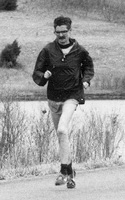Joe Henderson's Running Commentary - June 1960
CHICAGO, IL, June 1960. "Look at this," Dad said, pointing to a notice on a back page of the Sunday Chicago Tribune. A listing under "Today in Sports" read, "Track Meet, Stagg Field, noon. Open to all. Entry fee 50 cents per event."
We drove the farm pickup that same day to the University of Chicago campus on the city's south side. Stagg Field, named for legendary coach Amos Alonzo Stagg, now matched its surrounding neighborhood. Both were crumbling.
The grandstands might have collapsed if more than a dozen fans sat down at once. But there wasn't any risk of that happening this day.
We saw no crowds. No one stood at the open gate selling or collecting tickets.
Neighborhood kids, all Negro (the polite term at the time), played in the jump pits. The few athletes on the track and infield were dressed for training, not competing.
"Maybe we have the wrong day," I said. "Look, it's almost noon, and there isn't any sign of a meet."
A white-haired, pink-faced man with a clipboard walked past us. "He looks official," I told Dad. "I'll ask him."
This was Ted Haydon, coach at this school and founder of the University of Chicago Track Club. He would put three runners on the Olympic team that summer.
"Sir," I said to him, "is there going to be a meet here today?"
"If anyone shows up."
"What running events are you having?" I asked.
"We always have just one sprint, one middle-distance and one long-distance race." He showed me the clipboard listing a 100-yard dash, a half-mile and a three-mile for this meet.
"Which do you want to enter?" He said this as if there was no question that I had come to run. Why else would anyone be here?
"Put me down for the three-mile, I guess?" I hadn't trained for speed since track season ended and didn't want to embarrass myself with a slow time at a known distance, the half-mile.
"You're first on the list," said Haydon. The event would go ahead as long as one other runner entered.
"That's our policy. It only takes two runners to make a race."
I learned here what real distance is and what true competition can be. Neither was what I'd previously thought them to be.
One-point-eight miles of cross-country had been my longest race, and I'd never run beyond a mile on the track. Now I could set a personal record just by finishing.
Before, I'd thought that racing was a formal, tense, me-against-the-world business. The casually dressed runners I saw at Stagg were indeed here to race. But they neither looked nor acted the part.
These were older runners than I'd ever seen -- men in their 20s and beyond. The look of terror that I always wore before races was absent from their faces.
Two of them caught up with me as I warmed up in an outside lane. "Haven't seen you here before," said a crewcut blond. He introduced himself as Gar Williams, a name I knew from the How They Train book.
"Are you running the three-mile?" asked the other. This was Hal Higdon, who not only appeared in that same book but had illustrated it with his drawings. I knew him as a writer in sports magazines as well as a contender for the Olympic steeplechase team.
Williams and Higdon were competitors in this three-mile, yet they warmed up together. Imagine that, acting like friends before a race.
 |
|---|
Arne Richards (photo from Russ Niemi) |
They rocketed away from me at the start and would finish more than a lap ahead.
Another runner fell into my pace. He asked in a high-pitched voice, "What do you plan to run today?" Imagine that, asking another runner's strategy.
When I admitted not knowing, Arne Richards said, "This pace seems about right to me. We can help each other." Imagine that, competitors cooperating.
Dick King was the oldest runner here, well into his 30s. He was also the slowest of us, finishing more than a lap behind me. Imagine that, not being embarrassed to be slow.
This race and these elders of the sport set me to thinking about a longer future -- in miles and years -- that I'd imagined up to now.
(Arne Richards, only in his mid-40s, would die in 1979 while running. Gar Williams would serve multiple terms as president of the Road Runners Club of America. Ted Haydon would become an assistant coach on the 1972 Olympic staff.)
--------------------------------------
Rich Ayers put me in touch with Joe Henderson a few years ago. He is a retired writer for Runner's World and he now sends me a weekly article for SeeKCrun. I want to share this week's article...I think you will like it? - Dick Ross
The Arne Richards award is given out each year at the Hospital Hill Run for service to the running community in Kansas City.